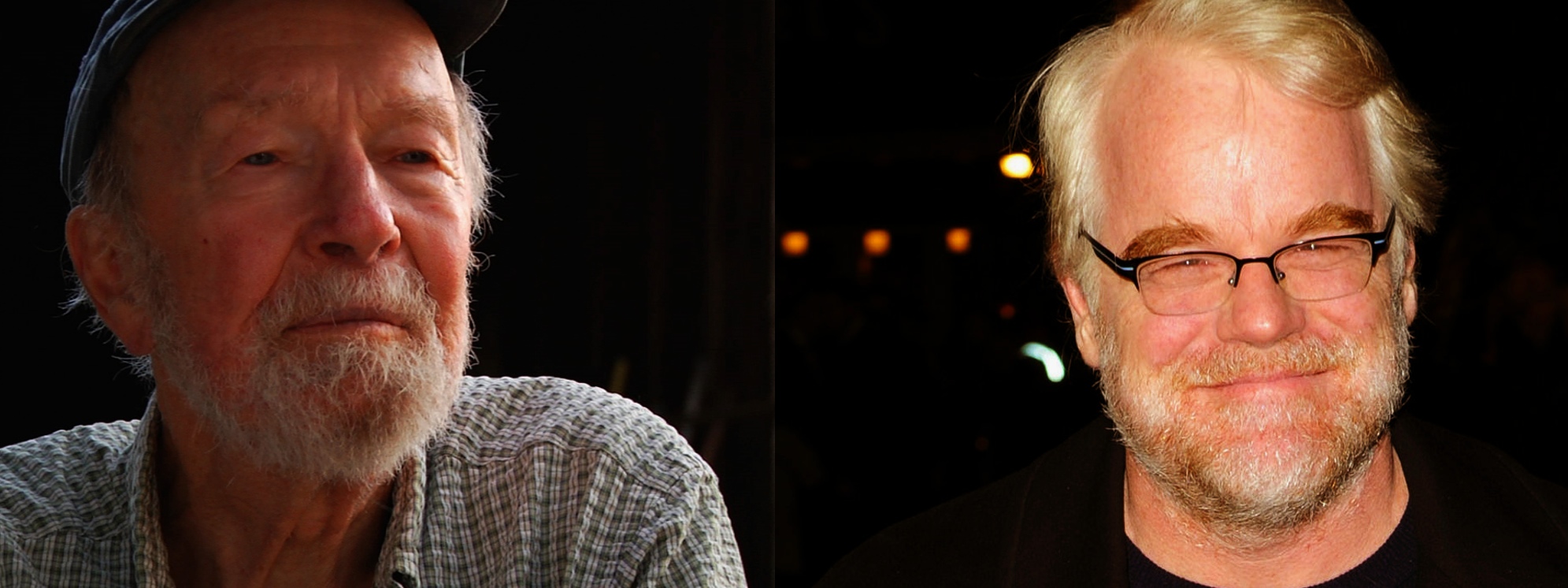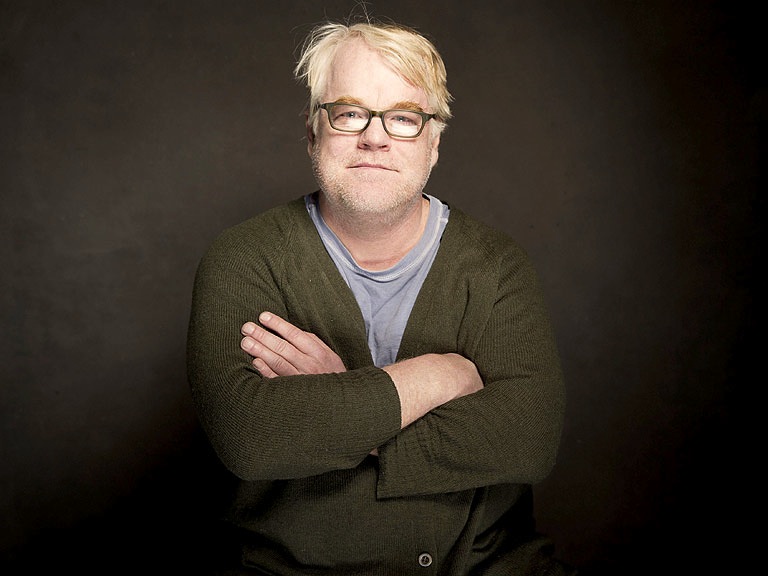Early into 2014 we have lost two very different yet inspirational performers who had a very unique way of bringing their interior selves outward in a transformative approach and response to a very real and tempestuous world. Pete Seeger, born in 1919 passed away on January 27th, 2014 at the ripe old age of 94. Philip Seymour Hoffman, born 1967 died of an apparent drug overdose on February 2nd, 2014 at the all too young age of 46. Both men, lived very different lives, Seeger left his band The Weavers in 1958 after they agreed to provide the vocals for a cigarette commercial on television, Philip Seymour Hoffman recognized drugs and alcohol as a problem getting sober at 22 only to relapse 23 years later which lead to his untimely death. Pete Seeger sang songs of courage, uprising, action, and hope while Philip Seymour Hoffman projected similar yet quieter sentiment through the often quirky yet relatable characters he played on film and in theater. Hoffman was able to transform into a role in such a way where it was possible to forget the actor behind the part, the two personas merging into one. Such is not an easy task and often actors, especially those with a particular celebrity, are so recognizable that they are forever destined to have to work harder to be rid of their public selves. Seeger, performed into his 90s, working with children and even won a Grammy in 2011 for “Tomorrow’s Children” featuring the “Rivertown Kids” from Beacon, New York. As one of the most visible hero’s of the folk movement and with early songs such as “Where have all the flowers gone?”, “Turn, Turn, Turn” and “If I had a hammer”, Seeger peacefully brought the reminder of the right to protest, carried in the pitch of his voice for over 77 years. While his form of hope was quite different from that of Hoffman’s, both men had a way of communicating through a subtle glimmer in their respective blue eyes and a soft smile. Seeger a slight man and Hoffman a bit more robust, each had a body language that seemed lackadaisical, in contrast with the passionate performances they both gave leaving audiences breathless in very different ways.
As a child, I saw Pete Seeger in concert with Arlo Guthrie in the auditorium of a school in Long Island. I remember sitting center stage in the second or third row with my mother, sister and grandmother, singing along to his well-known folk anthems. Even as a child I was aware of the hopeful melancholy of the lyrics. “Where have all the flowers gone?” written in 1955 is a perfect example of something that is laced with hope, reflective of an uncertain time and yet somehow sad, to a child’s ears, left with visions of fields stripped of their colorful adornment.
Where have all the flowers gone? Long time passing/Where have all the flowers gone? Long time ago/Where have all the flowers gone?/The girls picked them, every one/Oh, when will they ever learn?/Oh, when will they ever learn?
Where have all the young girls gone? Long time passing/Where have all the young girls gone? Long time ago/Where have all the young girls gone?/They’ve taken husbands, every one/Oh, when will you ever learn?/Oh, when will you ever learn?
Where have all the young men gone? Long time passing/Where have all the young men gone? Long time ago/Where have all the young men gone?/There all in uniforms/Oh, when will we ever learn?/Oh, when will we ever learn?
The song functions as both a prayer and a plea. It asks simple questions with much deeper, political meaning. With straightforward and comprehensible illustrations, Seeger paints a grim picture of war, of loss and a society on the brink of the Vietnam war which began in 1955 and would stretch until 1975 with estimated deaths of all countries involved to be close to 3.8 million. In the realm of the concert, the audience was often recruited for audio participation, echoing back the words of the singer a mirroring of participation and a reminder that protest need not necessarily be physical but by just being present and raising one’s voice, can a message be shared in a larger context. The birth of the protest song.
Philip Seymour Hoffman first came to garner public attention in his role as George Willis Jr. a classmate to Chris O’Donnell in The Scent of a Woman, also starring Al Pacino. Many years and feature films later, he starred in Magnolia, written and directed by Paul Thomas Anderson. Here he played a caretaker to a dying patriarch played by Jason Robards. With other actors who have found fame outside of mainstream Hollywood including William H. Macy and John C. Reilly, the film is an epic tale of familial bonds, loss and love which culminates in a Shakespearean storm, a chaotic moment where the sky rains frogs mimicking the absurdity of the moment. Also in theaters in 1999, he was featured in The Talented Mr. Ripely with Matt Damon, Almost Famous directed by Cameron Crowe in 2000, Punch-Drunk Love in 2002, Along Came Polly with Jennifer Anniston in 2004 and Capote in 2005 where he played Truman Capote in an otherworldly way, essentially becoming the author, and winning the Oscar for Best Actor in 2006. This was followed by roles in The Savages and Before the Devil Knows You’re Dead both in 2007, Synecdoche written and directed by Charlie Kaufman and Doubt with Meryl Streep 2008, The Master with Joaquin Phoenix in 2012 along with many others. The actor went to New York University Tisch School of the Arts to study acting and it was during this time that he realized that drugs and alcohol were a problem in his life. Rather then continue down this path, he chose a career in acting.
He continued this lifestyle choice for 23 years, supposedly until a wrap party for The Master, when he had a drink to celebrate the completion of the film. This one drink opened the door to further usage and eventually his death at the age of 46. The actor was found in his Greenwich Village residence, a needle still in his arm, glasses still perched on his forehead. Leaving behind a former longterm partner and three children as well as a legacy we will now relinquish as it will no longer continue, Hoffman, although in and out of recovery, finally succumbed to the illness of his addiction. Within the circumference of life, certain substances, can be used as an out, while physically present the mind and all control is lost. Upon the announcement of his death, reactions sprung up throughout social media from the public, other celebrities, those who knew him personally and those who solely admired his honest and thoughtful portrayal of characters in film and on stage. He also played the downtrodden Willy Loman in “Death of a Salesman” on Broadway in 2012 and later said it was the best part he had ever taken on. Now we, fans, friends, neighbors and peers, are left with the archive of films he made and might always wonder what would have been. I honestly felt that I would grow old with Hoffman, through his many portrayals of regular people who in all their flaws carried a sense of grandeur. His death, brought on by an overwhelming compulsion, is one that will affect Hollywood for years to come. With his slightly turned down grin, floppy blond hair and wry earnestness, there are actors who will play roles intended for Philip Seymour Hoffman, but there will never be an actor or person who can replace or play the man himself and this is worth mourning.
Many actors and other celebrities have made statements regarding the loss, addiction and sadness. One such comment worth mentioning, by way of twitter, came from Jim Carrey who wrote,
“Dear Philip, a beautiful beautiful soul. For the most sensitive among us the noise can be too much. Bless your heart.”
Another actor who felt compelled to contribute something to the conversation around the suspected overdose, was British actor Russell Brand who wrote an article for The Guardian, titled Russell Brand: Philip Seymour Hoffman is another victim of extremely stupid drug laws, (Thursday 6th, February, 2014). In the candidly written article, Brand who is admittedly a recovering alcoholic and drug user, states in the very first sentence “Philip Seymour Hoffman’s death was not on the bill.”
He then goes on to discuss the sordid , fetishization of addiction and the almost glorified anticipation of the downward spiral of someone in the public eye. Pointing to Miley Cyrus and the recently arrested for D.U.I. Justin Bieber, Brand scoffs at the generation of what he calls eMpTyV and the inevitable voyeuristic practice that follows any trace of suspicion where an outwardly excessive lifestyle that can be associated with fame eventually lends itself to an untimely, all too soon, death. However, with Hoffman, Brand is quick to point out that the actor was middle-aged and well respected both inside and outside the acting community, so his unglamorous death in solitude is decidedly ‘bleak’. Later stating,
Philip Seymour Hoffman’s death is a reminder, though, that addiction is indiscriminate. That it is sad, irrational and hard to understand. What it also clearly demonstrates is that we are a culture that does not know how to treat its addicts. Would Hoffman have died if this disease were not so enmeshed in stigma? If we weren’t invited to believe that people who suffer from addiction deserve to suffer? Would he have OD’d if drugs were regulated, controlled and professionally administered? Most importantly, if we insisted as a society that what is required for people who suffer from this condition is an environment of support, tolerance and understanding.
It’s difficult to say if tougher drug laws would have made a difference in this death or others. I tend to think that if someone wants drugs, they will find a way to gain access whether legal or not. Such was the case with Hoffman who had close to 70 bags of heroin in his apartment. That is not the number of a casual user. He was obviously in a dark place and digging deeper. The most difficult details though revolve around his active struggle to stay or rather return to a sober lifestyle. Even though his end resulted in an action that he administered, the severity of the addiction rendered him powerless and the only person who could have saved him, was the one reflected back in the mirror every morning, the one he probably saw out of the corner of his eye in the bathroom before collapsing to the ground, Philip Seymour Hoffman and a power greater than himself.

One week later, Founding Editor of ETTD and author Katy Diamond Hamer in front of the Hoffman residence in Greenwich Village,
Photograph, 2014
In excerpt; “Well I got a hammer and I got a bell
And I got a song to sing all over this land
It’s the hammer of Justice, it’s the bell of Freedom
It’s the song about Love between my brothers and my sisters
All over this land” Written by Pete Seeger and Lee Hays in 1949.
In a performance from 1956….
Then again in 2013 at the age of 94, just four months before his death, as part of a Farm Aid concert held in Saratoga Springs, NY. The performance is evidence of tenacity and how life is unpredictable and worth fighting for. Sending prayers to the families and friends of both men, lost in very different ways. I hope that wherever they are now, they are both smiling.
More soon
xo



